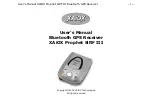
1 GPS Fundamentals
1.1 Theory of operation
Basic Signal Processing (ANTARIS
®
GPS Technology)
Data
Output
Down
conversion
Filtering
A/D
Conversion
Navigation
Calculation
Acquisition
Correlator
1
Correlator
2
.
.
.
Correlator
16
RF
Input
Analog
Signal
1.575 GHz
Digital
IF
signal
Pseudorange
Carrierphase
Orbit
Information
per SV
Position,
Velocity
Time
Solution
Serial
Output
RF Section
GPS Channels
Navigation
Interface
Figure 1: Basic Signal Processing
The
ANTARIS
®
4
GPS
receiver
is
an
L1
Frequency
(C/A
Code)
GPS
receiver
and
performs
the
entire
GPS
signal
processing,
from
antenna
input
to
serial
position
data
output.
The
processing
steps
involved
are:
1.
RF
Section
In
the
RF
Section
the
GPS
signal
received
by
the
antenna
is
amplified,
filtered
and
converted
to
an
intermediate
frequency
(IF).
An
A/D
converter
changes
the
analog
intermediate
frequency
into
a
digital
IF
signal.
2.
GPS
Channels
The
digital
IF
signal
bit
stream
is
passed
to
the
baseband
section,
where
it
is
fed
into
the
correlators.
It
is
the
function
of
the
correlators
to
acquire
and
track
the
satellite
signals.
There
are
16
channels
used
in
parallel,
with
each
correlator
looking
for
a
characteristic
PRN
code
sequence
in
the
bit
stream.
Once
the
correlator
has
identified
a
valid
signal,
Pseudorange,
Carrier
Phase
and
Orbit
Information
can
be
extracted
from
the
GPS
signal.
3.
Navigation
The
on-board
processor
runs
an
algorithm
that
calculates
the
position,
velocity
and
time.
This
calculation
is
called
the
navigation
solution.
Once
the
navigation
solution
is
calculated,
it
can
be
transformed
into
the
desired
coordinate
system,
e.g.
Latitude/
Longitude/
Altitude.
4.
Interface
The
data
of
the
navigation
solution
is
available
at
the
serial
RS232
or
USB
interface.
GPS
Modules
-
System
Integration
Manual
(SIM)
(incl.
Reference
Design)
GPS
Fundamentals
GPS.G4-MS4-05007-A1
Page 11












































